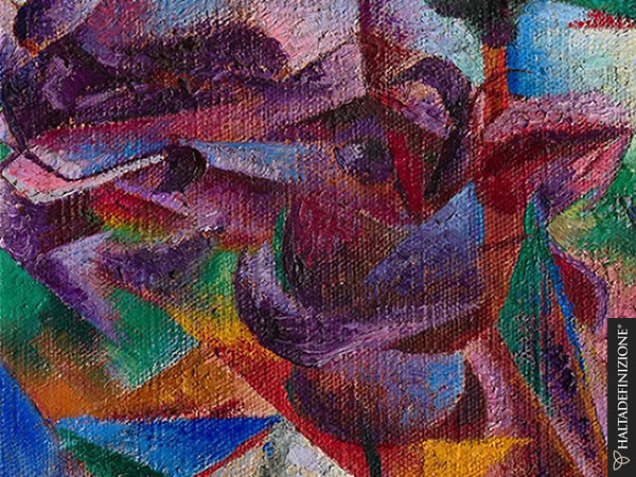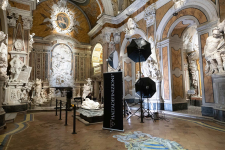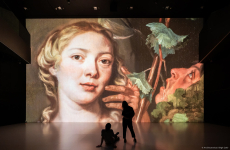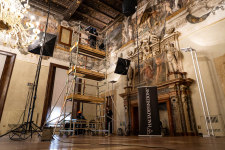In January, after some structural renovations, the Museum of the Twentieth Century began collecting ultra-high definition images of a selection of masterworks, with technology developed by Haltadefinizione’s partner company Memooria, in order to support conservation efforts and to make the works more available to the general public.
The selection represents the main international avant-garde movements and the greatest painters of the twentieth century, including Elasticity (1912) and Human Form (Dynamism, 1913) by Umberto Boccioni, the Portrait of Paul Guillaume by Amedeo Modigliani (1916), Composition by Kandinsky (1916) and Wald Bau by Paul Klee (1919). All are now available in ultra-high definition gigapixel format.
Viewers of the multimedia system can zoom in and explore these images and see what isn’t visible when viewing them from a distance the usual way, even down to the texture of the canvas and the individual brush strokes. The system can enlarge up to 40x, which opens the door to many new ways of making the art available to people, as well as to supporting conservation and scholarship.
Even if the works are enclosed in glass cases for conservation, digital photography was still done with excellent results in terms of definition, quality of image detail and color fidelity. Being able to digitize works even if they are enclosed under glass, in climate controlled cases or sealed displays, guarantees optimum conditions throughout the digital acquisition process.

Ultra-high definition gigapixel digital files are created by taking a large number of individual still photographs of portions of the same subject. The digital image of Modigliani’s Portrait of Paul Guillaume, one of his most famous works, is made up of 779 single shots, with a resolution of 1,100 pixels per inch (PPI). The works of Boccioni and Kandinsky were done at that same resolution.
The case of Klee’s Wald Bau is different, as it was photographed with a technique called focus stacking, which yields a better depth of field, by taking a series of shots of the same frame, with the focus on a different plane each time. The higher the resolution desired, the more shots must be taken. For Klee’s work, 1,320 shots with a resolution of 2,100 PPI, and the digital acquisition included the making of a 3D map of the painting.
“In 2015 we first worked with the Museum of the Twentieth Century in Milan on the digitization of The Fourth Estate by Pellizza da Volpedo,” says Luca Ponzio, founder of Haltadefinizione. “As an institution they have a strong vision of the future of applied technology, not only in conservation but also in making better experiences for visitors, whether at the museum or virtually.”
The ultra-high resolution data collected during the recent digital acquisition of these works has revealed that they are in excellent condition. They are now available for public viewing at the Haltadefinizione website, an ideal compliment to the sensory experience of visiting the actual Museum of the Twentieth Century.
The Works
Umberto Boccioni, Elasticity, 1912, Oil on canvas
A man riding a horse, a recurring subject for Boccioni, is seen in the periphery of a city, among houses, factory chimneys and parts of electrical transmission towers. More then a celebration of technology, Boccioni’s Futurism focussed on the anatomical portrayal of movement. Elasticity is one of his most celebrated works and stands as the finest example of Futurist dynamic style, compared to the static imagery of Cubism.
Umberto Boccioni, Human Form (Dynamism), 1913, Oil on canvas
This work probably dates from the Autumn of 1913, when Boccioni began painting the human body in motion after having begun experimenting with the same subject in sculpture. The artist solves the problem of tension and changing positions of the muscular mass in space, through the complimentarity of colors. The artist wrote to his friend Giovanni Papini on October 13, 1913, “You can only seek life-like motion, and how to give a body depth by making its form shift from red in the light to a complimentary green in shadow.”
Amedeo Modigliani, Portrait of Paul Guillaume, 1916, Oil on canvas
Paul Guillaume was a French art collector and patron. He is portrayed in a pose first seen in a series of photographs taken in 1915 in Modigliani’s studio. The carefully drawn facial features, its almost sculptural execution and its use of Cubist visual language in the angular drawing of the face, combine to make it one of Modigliani’s most important works. The painting belonged to Guillaume’s collection until the 1930s, when the Galleria del Milione in Milan acquired it. Over the years it has attracted a lot of attention from critics and the public, and it was purchased by a series of private owners until its final purchase by the municipal government of Milan in 1952.
Vasilij Kandinsky, Composition, 1916, Watercolor and pencil on paper
Composition first appeared as Study for Bild mit zwei roten Flecken (or Illustration with Two Red Spots), a lost work that is only known by photographs and documentation of its having been sequestered by Nazi Germany as so-called degenerate art. The watercolor, which is very similar to the lost work, includes two spots of red, a color that Kandinsky used to show expansive strength. Set in a recurring and dynamic diagonal direction, Kandinsky poses the issue of spatial depth on the flat surface of a page, where marks, lines and combinations of forms and color produce a visual effect of moving farther away or closer, depending on the observer’s point of view. The painting became part of Milan’s municipal collection in 1992 as part of the acquisition of the Jucker Collection, which brought a nucleus of twentieth century international avant-garde works to the collection.
Paul Klee, Wald Bau (Forest Construction), 1919, Mixed media with gesso on canvas with cardboard backing
After the second World War, Klee, seeking to renew his visual language, turned to nature, to medieval miniatures, to children’s drawings and African sculpture to build an immense repertory of archetypal forms and conventional imagery. Seen from above and with its shape reduced to a set of signs, landscape painting lends itself to the creation of a new world.



